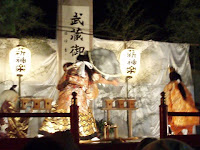Emperor Sujin is the 10th Emperor and he appears in the Japanese myth Kojiki. So, the shrine was established as far back in the past as when main players of the myth were actually alive.
My friends and I visited this shrine to see takigi kagura (shinto music and dance performed under bonfires) on October 11.
Here, I present some photos taken during the performance.
(1) Urayasu-no-mai (dance praying for peace)
This number was performed by two junior high school girls. The dance and music are performed following lyrics composed by Emperor Showa. The lyrics say "I pray to the gods of the heavens and earth that the world may be peaceful like a calm sea in the morning that is not agitated."


(2) Hohei (offering of a sacred wooden stick to which paper strips hang down)
This dance is performed to purify the stage. The photo may not convey the atmosphere, but the performer danced a merry and rhythmical dance.


This performance represents a scene where a blade smith makes a celebrated sword with help from the god Inari (a god of harvests).


(4) Amano-iwato (rock door of the heavens)
This performance represents the legend describing how gods took out Amaterasu-ookami, who disappeared behind the rock door of the heavens. According to the Japanese myth Kojiki, since Uzumeno-mikoto goddess danced while baring her breast and slipping off her clothes down to expose her private parts, all the gods there broke into explosive laughter. Amaterasu-ookami opened the rock door slightly and watched out from curiosity. At this time, she was taken out of the door. Uzumeno-mikoto is probably the Japan's first nude dancer, but she stayed clad on the stage set up in front of the shrine.
Tajikaraono-mikoto, who is renowned for his unparalleled strong power, holds the rock door and throws it away in the photo on the right.


(5) Mountain god
This is the last number of this series of kagura performance. Kagura is dance and music to be dedicated to gods when food is offered to the gods. Rice cake is prepared as offering, and the performer of this performance throws the rice cake to spectators. So, we are given good luck from the gods.
I could collect seven pieces of rice cake. Since the rice cake is said to protect people from diseases and keep them sound, I brought it home and ate it with family. Thanks to the gods.

Mitake Shrine pavilions are on the summit of Mt Mitake, which stands 929 m above the sea level. Takigi kagura was performed in the open space in front of the torii gate that is located at a lower point than the shrine pavilions. Due to high elevation, it was cold at night in October. Even subtle warmness coming from the two bonfires placed on both sides of the stage along with the scent of soot was felt nice to me.
The dancers' clothes that emerged in the light of fire were sparkling as if they were corresponding to the flaring flames of the bonfires, drawing the audience into a world of illusion.
Today's Sake
Asazume-no-sake Sawanoi Honjizake (Ozawa Syuzou)
Ordinary Honjizake of Sawanoi except that it was bottled and pasteurized in the morning of October 1, the "Sake Day." When I bought this bottle in the evening, it was still slightly warm. I wanted the sake to stay warm until I brought it back home. So, I put the bottle inside my jacket and carried it. I could feel the subtle warmness of the sake and I felt my heart becoming warm.
Junmai sake with rich and bold taste.
Seimaibuai: 65%
Alcohol: 15 - 16%
Sake meter value: -1
Acidity: 1.6

No comments:
Post a Comment